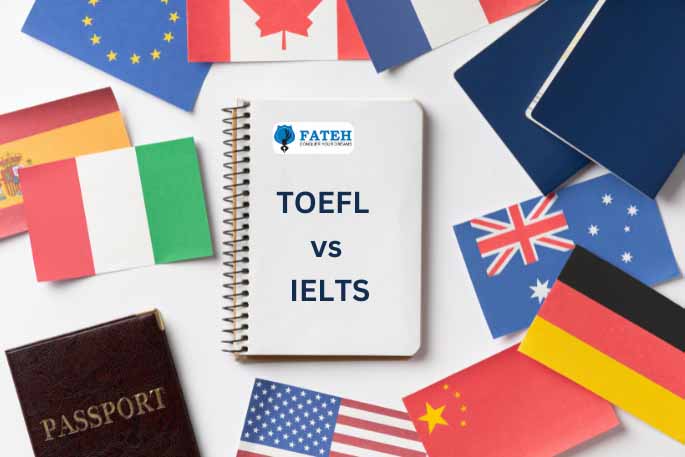Introduction
In an increasingly globalised world, proficiency in English has become a critical skill, especially for students who aspire to study abroad. For Indian students, demonstrating English language proficiency is often a prerequisite for admission to universities in English-speaking countries. Two of the most popular exams that test these skills are the TOEFL (Test of English as a Foreign Language) and the IELTS (International English Language Testing System). Choosing between TOEFL and IELTS can be challenging, as each test has its own format, focus and advantages. In this blog, we will discuss the differences between these two exams, focusing on which might be easier for Indian students and helping you decide which one is the best fit for your needs.
Understanding TOEFL and IELTS
Overview of TOEFL
The TOEFL is a standardised test conducted by the Educational Testing Service (ETS), designed to measure the English language proficiency of non-native speakers. It is widely accepted by many colleges and universities in the United States, Canada and various other countries. The TOEFL iBT (Internet-based Test) is the most common format, although a paper-based version is also available in locations where internet access is limited. The test evaluates four key language skills: reading, listening, speaking and writing.
Overview of IELTS
The IELTS is handled by the British Council, IDP: IELTS Australia and Cambridge Assessment English. It is accepted by over 11,000 organisations worldwide, including universities, employers and immigration authorities in countries like the UK, Australia, Canada and New Zealand. IELTS comes in two versions: academic and general training. While the academic version is for those applying for higher education, the general training version is suitable for work experience or training programs. Similar to TOEFL, IELTS also tests reading, listening, speaking and writing skills.
Key Differences: TOEFL vs. IELTS
Here’s a comparative overview of the key features of both exams:
| Features | IELTS | TOEFL |
|---|---|---|
| Types of Exams | Academic, General Training | TOEFL iBT, TOEFL Test on Paper |
| Organiser | British Council, IDP: IELTS Australia, Cambridge Assessment English | Educational Testing Service (ETS) |
| Fee | INR 17,000 | INR 16,900 |
| Structure | Reading, Writing, Speaking and Listening | Reading, Writing, Speaking and Listening |
| Duration | 2 hours 45 minutes | 1 hour 56 minutes |
| Score Range | 1 to 9 | 0 to 120 |
| Results Availability | 3 to 5 days | 6 to 10 days |
| Popularity | Popular in Canada, UK and Australia | Popular in USA, Canada |
| Acceptance | 11,000+ International Colleges | 11,500+ International Colleges |
Exam Structure and Format
TOEFL Test Format
The TOEFL iBT test is conducted online and is split into four sections: namely reading, listening, speaking and writing. Each section is designed to measure specific language skills through tasks that simulate real-life academic scenarios. Here’s a breakdown of the TOEFL test format:
| Section | Number of Tasks | Duration (minutes) |
|---|---|---|
| Reading | 3-4 Passages (12-14 questions each) | 54-72 |
| Listening | 3-4 Lectures, 2-3 Conversations | 41-57 |
| Speaking | 4 Tasks | 17 |
| Writing | 2 Tasks | 50 |
IELTS Test Format
The IELTS exam has four sections: reading, listening, speaking and writing. Unlike TOEFL, the IELTS Speaking test is conducted as a face-to-face interview with an examiner. Below is an outline of the IELTS test format:
| Section | Number of Tasks | Duration (minutes) |
|---|---|---|
| Reading | 3 Passages | 60 |
| Listening | 4 Sections | 30 |
| Speaking | 3 Parts | 11-14 |
| Writing | 2 Tasks | 60 |
Scoring and Assessment Criteria
How is TOEFL Scored?
How is IELTS Scored?
TOEFL vs. IELTS: Section-by-Section Comparison
Reading Section:
- TOEFL features academic texts with multiple-choice questions, focusing on comprehension and vocabulary.
- IELTS includes a mix of academic and general interest texts with various question types such as multiple-choice, matching and true/false.
Listening Section:
- TOEFL consists of longer, more complex lectures and conversations typical of a university setting.
- IELTS involves a variety of recordings, including monologues and conversations on general and academic topics, often shorter and with different accents.
Speaking Section:
- TOEFL is conducted online, where students speak into a microphone, responding to prompts.
- IELTS involves a face-to-face interview with an examiner, offering a more personal interaction.
Writing Section:
- TOEFL includes integrated tasks combining reading, listening and writing and independent writing tasks.
- IELTS has two tasks: a description of a chart or graph and an essay on a given topic.
Score Comparison:
- TOEFL scores range from 0 to 120, with most universities requiring a score between 70 and 100.
- IELTS scores are on a 1 to 9 band scale, with a score of 6.5 or 7 being commonly accepted by universities.
Difficulty Levels
TOEFL or IELTS for Indian Students: Which is Easier?
The perceived difficulty of TOEFL versus IELTS can vary among Indian students depending on their strengths and preferences. Understanding the IELTS band scoring system is crucial for setting appropriate targets for your university applications.
- Familiarity with Test Format: Some students might find TOEFL easier due to its multiple-choice format, which can be more straightforward for test-takers who are accustomed to this style. In contrast, IELTS includes different types of questions, which may require more adaptability.
- Speaking Section: The face-to-face interaction of IELTS may appeal to students who are comfortable speaking English in conversation, while others might prefer the computer-based speaking tasks in TOEFL, where interaction is less personal.
- Listening Section: Indian students who are more accustomed to the American accent might find TOEFL’s listening section easier. IELTS, however, includes a range of accents (British, Australian, etc.), which might pose a challenge.
- Reading and Writing Sections: The TOEFL’s focus on academic English can be advantageous for students with strong reading and writing skills in a formal context. IELTS, with its mix of academic and general content, may be more accessible to those with a broader range of English proficiency.
Comparison of Difficulty Levels
| Aspect | TOEFL | IELTS |
|---|---|---|
| Speaking | Less personal, computer-based | More personal, face-to-face |
| Listening | Primarily American accent | Multiple accents |
| Reading | Academic passages | A Mix of academic and general |
| Writing | Integrated tasks | Separate tasks |
Choosing the Right Exam
- University Requirements: Check the specific language test requirements of your chosen universities.
- Preferred Test Format: Choose the test that aligns with your comfort in test-taking (e.g., computer-based vs. face-to-face).
- Test Availability and Location: Consider the availability of test centres and dates in your area.
- Cost and Convenience: Factor in the costs of the exams and the logistics involved.
Tips for Preparation
- Understand the Test Format: Be familiar with the format and types of questions in both exams.
- Practice Regularly: Use practice tests to get comfortable with timing and question types.
- Improve Listening Skills: Engage with different English accents and dialects.
- Enhance Speaking Skills: Practise speaking on various topics, both in a conversational and academic style.
- Focus on Time Management: Develop strategies to manage time effectively during the test.
Conclusion
Both TOEFL and IELTS are globally recognised English language proficiency tests, each with unique features and formats. However, many students are now also considering PTE as an alternative option that offers computer-based testing with fast results. For Indian students, the choice between the two will depend on personal preferences, familiarity with test formats and specific university requirements. By understanding the differences and assessing individual strengths, students can make an informed decision, ultimately choosing the test that best suits their academic and career aspirations.
FAQs
An IELTS score of 7.5 roughly translates to a TOEFL iBT score of around 102–109. Both scores reflect a high level of English proficiency and are accepted by top universities and immigration authorities worldwide.
Neither is universally “better” — the choice depends on your destination and purpose. IELTS is widely accepted in the UK, Australia and Canada, while TOEFL is preferred in the United States. For academic purposes, both are equally valid; it comes down to test format preference and where you are applying.
Choose based on your study destination and comfort with test format:
- Pick IELTS if applying to the UK, Ireland, Australia or New Zealand
- Choose TOEFL for the United States and some Canadian institutions
- IELTS includes face-to-face speaking, while TOEFL is fully computer-based — opt for the one that suits your strengths.
IELTS scores are valid for two years from the test date. After this period, you will need to retake the exam if required by your institution or visa process.


